- HOME
- BEST POKER TRAINING SITES
- POKER GUIDES
- ONLINE POKER ROOMS GUIDE
- POKER NOTES LIVE APP
- MORE
Ace King is one of those Hold’em hands that players either love or hate. There seem to be many different theories about how to play Big Slick correctly, although some of them have no math or logical explanation behind it.
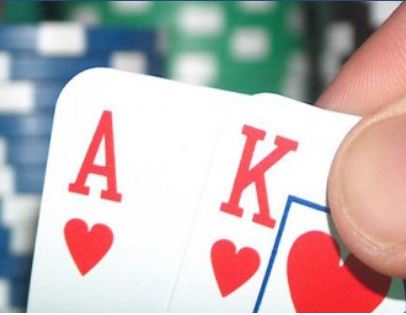
The number one reason why players often remember losing with this hand is because of their expectations to be always winning. Also, AK has more combinations than, say, AA, so you will be getting this hand more often, which could give you the illusion of losing.
So while some players believe Ace-King is a marginal hand, it can be one of the most profitable hands when played correctly. The truth is that even against an extremely strong range of 99+, AQ+, AJs+, this hand is a slight favorite.

So the question is not if this holding is good enough to stack off with, but rather about finding the optimal way to play it to maximize your results.
While everyone seems to have their own approach and ideas on how to play Ace-King, sticking to these few simple tips will help you to avoid most of the problems with this hand.
Ace-King is strongest before the flop, where you’re likely to have a mathematical edge over most opponents’ ranges. That’s why you’ll want to drive the action before the flop is dealt and build as big a pot as possible during this stage of a hand.
While you can break every strategic concept into many smaller pieces, the simplest advice I can give you about playing AK is – raise. Whatever happens in front of you, when the action comes to you, just raise!
As long as you’re playing at a standard stack depth (of 100 big blinds or fewer), you’ll almost never be wrong to commit your entire stack before the flop, so you should build that habit of raising.
Sure, if you know that the raise and 3-bet are coming from the nittiest player you’ve ever met, you could reconsider. But, as a general rule of thumb, if you have a big slick and an option, always raise to build the pot.
There are hands in Hold’em you can use to try and trap your opponents, but Ace-King isn’t one of those hands. You don’t want to play AK in a way that allows four other players to see the flop with you if you can help it.
This hand flops well, but flopping top pair / top kicker isn’t nearly as strong against multiple opponents as it is against a single player. Furthermore, if you don’t put out some bets and raises before the flop, you’ll have absolutely no idea what other players’ ranges look like.
If you decide to slow-play AK and end up stacking off on an A 10 8 board against 10-8 suited from one of your four opponents, the question you need to ask yourself is whether you did all you could to be in a better situation. (The answer is usually “no”.)
If they paid your 20 big blinds squeeze with this hand, then there is nothing to worry about, and you will get them next time if they keep making such mistakes. But if you played it slow and just called someone’s raise for three big blinds and let everyone behind you in, you may get a hint of why this isn’t such a good idea after all.
Continuing on the above advice, if you do find yourself in the multi-way scenario, you need to be very careful. If you miss the flop, your default course of action should be to check and give up. This is especially true if there are more than two other opponents still active in the hand.
Against a single opponent, you’ll still be looking to c-bet and win a pot even when you miss entirely. This strategy will work a fair percentage of time as your opponent will likely miss as well, and you are the one with the initiative. Even if you face a bet from your opponent in a heads-up pot, you are likely to be ahead and can call at least once, which is not the case against multiple players.
In multi-way pots, though, the likelihood of someone catching a piece of the flop increases exponentially. People these days won’t fold a middle pair to a single bet on the flop, so by bluffing into several opponents, you’re likely bloating a pot that someone else is going to end up winning.
This isn’t to say that you have to give up 100% of the time when you whiff, of course. You’ll still be able to continue with some gutshots or decent backdoor draws, but you should proceed very carefully.
Cardplayer Lifestyle would like to thank Red Chip Poker for their support of this column. Check out their ground-breaking “CORE” poker course and get started today for just $5
The Ladies GPI Rankings Recap will be a recurring monthly column (once live poker tournaments resume, of course) in which we will follow the women who are chasing top spot on the GPI leaderboard. We’ll chart their progress throughout the year as they race to win the 2020 GPI Female of the Year award.
The 2019 Global Poker Awards ceremony was held on March 6 at the PokerGO Studio in Las Vegas. Kristen Bickenell was crowned the Female GPI Player of the year for the third time in a row, having won this honor before in 2017 and 2018.
🌐♣️🏆 Back-to-Back-to-Back. The GPI Female Poker Player of the year: Kristen @krissyb24poker Bicknell#GlobalPokerAwards pic.twitter.com/LFwLxLtsjj
— Global Poker Index (@gpi) March 7, 2020
The yearly POY rankings include only a player’s best 13 scores from January 1-December 31 each calendar year. GPI scores are derived from a combination of a player’s finishing place percentage and buy-in factor. For GPI rankings, events must be open to the public, so Ladies Only events and senior events are not included. Full details and formulas can be found on the GPI website. The newest GPI scores are tallied every Friday.
Women from all over the world have stormed the felt this year and with tournaments like the 2020 Aussie Millions, WPT Fallsview, Rolling Thunder and Seminole, partypoker MILLIONS UK, and various WSOP Circuits both in the USA and internationally, there were many series to play to start earning points for the 2020 GPI Female of Year Leaderboard.
A first place finish in the NLH 6-Max the WPT LA Poker Classic and a second place at Bay 101 Shooting Stars has secured Kristen Bicknell the early lead in the 2020 Female POY race with 997.50 points, 200+ points more than 2nd place, Canadian Yuan Li.
Kristen Bicknell wins Event No. 63 ($71,970) at LAPC. Her Ac7d>Kh8d of Taylor Von Kriegenbergh on a final board dealt Ah7h7sAd3d. https://t.co/VjdHunSePA pic.twitter.com/cwVrVxA2t7
— LA POKER CLASSIC 2020 (@LAPC) March 3, 2020
Maria Constanza Lampropulos is in third position after her two final table finishes at the partypoker MILLIONS UK. Maria is an accomplished player, who has more than $3.3 million in recorded earnings. She holds a PCA Main Event title and a partypoker Main Event title but has yet to win the Female GPI POY award.
Alexis “Lexy” Gavin’s win at the RunGood series, third place at the WPT LAPC, and tenth place at Bay 101 Shooting Stars Main event, yielded points that have her currently placed fifth on the leaderboard. Lexy finished 19th in the 2019 GPI Female POY Rankings.
Second title of the week secured! Lexy @LexyGavinPoker Gavin cruises through a field of 272 players in the $185 RG DeepStack Ring Event at @HorseshoeIowa! She takes home $9,475 plus a RG All-Stars Ring! #AllStars #ProAm #Homecourt 🏟 pic.twitter.com/mRzEgCLJVL
— RunGoodGear.com (@RunGoodGear) February 7, 2020
Austria’s Jessica Teusl also made it into the top 10, which is mainly dominated by Canadian and USA players. She had three final table appearances at the CAPT Seefeld, including winning the €550 NLH Snow Festival event, which contributed to her point total of 507.81, good for ninth place.
| 1 | Canada | Kristen “Krissyb24” Bicknell | 997.50 |
| 2 | Canada | Yuan Li | 788.62 |
| 3 | Argentina | Maria Constanza Lampropulos | 704.45 |
| 4 | USA | Nadya Magnus | 678.32 |
| 5 | USA | Alexis Gavin | 669.19 |
| 6 | Canada | Louise Francoeur | 612.14 |
| 7 | USA | Kathy Liebert | 562.07 |
| 8 | USA | Lynn Griswold | 533.70 |
| 9 | Austria | Jessica Teusel | 507.81 |
| 10 | USA | Angel Velez | 497.12 |
Source: Global Poker Index, accessed on March 24, 2020
If we look at the Asia Pacific Region, many tournaments scheduled for February and March were either canceled (e.g., APL Danang, WPTDeepstacks Vietnam), moved (e.g., APT Danang, WPT Taipei) or played out with reduced guarantees (e.g., WPT Manila, APT Taipei). The Aussie Millions, despite the Australian bushfires, took place as scheduled in January.
Interestingly, Hui Chen “Kitty” Kuo who finished fourth in the GPI Female POY race in 2019, has only one cash so far in 2020, from the APPT Taiwan, which is not enough for a top 200 ranking. According to her very active Twitter account, she skipped Bay 101 due to coronavirus fears. Naturally, if and when she’ll be able to put in the volume and make deep runs once more, we’re likely to see Kitty climb that leaderboard.
I think for some health issue, I decide to skip @Bay101Casino this year, sorry for me last min cancel, be safe to all my friends in San Jose pic.twitter.com/ZRzU56qGiz
— kitty kuo thomas (@kittykuopoker) March 11, 2020
The international poker world continues to be shaken up with casino closures due to the COVID-19 pandemic. While the Hendon Mob has for all intents and purposes gone into “hibernation”, the last logged series results were from the Belarus Poker Tour and partypoker Sochi, but no women were in attendance. Other large series have either been cancelled, postponed, or moved online. As GPI points are not awarded for online poker tournament series, we will need to wait until live play begins anew for the next installment of the Ladies GPI Rankings Recap.
For many recreational players, the idea of playing online seems appealing, especially in our current world of social distancing and self-quarantine. But where do we start? What are the risks? Is it even legal? What should we be playing? What site should I use? Is my money safe?
The RecPoker panel of Steve Fredlund, Jim Reid, Chris Jones, Rob Washam, and John Somsky discuss these questions and more, highlighting John’s extensive knowledge and involvement with online poker and the personal experience playing online with the panel.
RecPoker has another additional related opportunity for you:
RecPoker has launched daily tournaments on PokerStars we are calling our Social Distance Series to help stay connected and sharp on the felt. Click HERE for detail about how to join.
RecPoker has some fantastic opportunities for Home Games & Bar Leagues to get promotion, recognition, and add opportunities for great prizes and experiences; all for super cheap (especially if you sign up before March 31, 2020). Click HERE for information on the Home Games, where you league can sign-up for $40 for an entire year; click HERE for information your Bar League, which costs only $100 for an entire year.
| 0:00 | Welcome & Introduction |
| 0:45 | RecPoker “Top Two” |
| 2:18 | Online Poker: History and Status |
| 15:06 | Online Poker: Risks to Consider (Shut Down, Bots, Cheating, Collusion, Withdrawals) |
| 26:55 | Online Poker: Options for Playing |
| 40:12 | Online Poker: Differences from Live Play |
| 45:44 | Online Poker: Tools to Use |
| 56:00 | RecPoker and ACR: Bonus Programs, Taylor Video Overview, Deep Dive Session March 30 |
| 59:00 | Online Poker: Getting Money into Account |
| 1:01:00 | Running Aces Player of the Week and Binks |
| 1:01:38 | Home Game Updates (including Social Distancing Series) |
| 1:04:35 | RecPoker Membership Content Updates |
| 1:05:22 | Closing Comments |
| 1:06:14 | Final Announcements |

Survivor fans know Shirin Oskooi from her appearances as a contestant on the long-running reality show. The former tech executive played the game in the Worlds Apart and Cambodia seasons of Survivor, and that experience led to Oskooi playing poker for the first time at Run It Up Reno in October 2018.
Oskooi enjoyed her first taste of poker so much that she started devoting serious time to the game. Other folks might be more into the gambling aspects and the idea of possibly winning big money, so they’d perhaps look into the advantages of new online casinos 2020 has to offer. Oskooi, by contrast, fell in love with the game of poker itself and is now plays full-time at events throughout the U.S.
I had the opportunity to chat with Oskooi about her journey from the technology industry to poker, and about what lies ahead in that journey for the Survivor alum.

Image credit: Katerina Lukina for PokerNews
Would you call yourself a full-time poker player now?
Yes; it’s weird to say and I don’t know why. I’m 37 and I have a full career in tech. I guess it’s because I haven’t been playing poker all my life and it’s still so new it. It feels weird to say I’m a full-time poker player.
Obviously, I still have so much to learn, and so much to do. But yeah, I am a full-time poker player.
Out of all of the things you could do, what brought you to poker?
So Jason Somerville is a huge Survivor fan. At Run It Up Reno, he always does a Survivor watch party, and there’s a little bit of Survivor overlap. A couple friends of mine, who are poker players and go just for the poker, invited me to join them, just for the Survivor part.
So I went in October 2018, and it just so happened that while I was there at that time they were doing a Survivor charity game. It was a sit ‘n go, and whoever wins donates a couple thousand dollars to their favorite charity.
They signed me up for it, and my friends gave me a crash course in poker. That was the first time I ever played. It was on stream with these other Survivors for this charity game.
And I just really took to it, I really enjoyed it. I thought a lot of the basics came to me pretty easily, so I was hungry for more.
The more I played, there were a couple things that really stood out to me. I didn’t care as much about whether I won or lost a hand. I cared more about did I do the right thing, and learning more of the strategy.
There’s a lot of overlap between poker and tech, and just life. There are more appealing things about poker to me. In tech, or your job, everyone is your co-worker, or an employee, or an executive.
Even though for the most part tech is pretty laid back, and can be very social, your job is still on the line all the time. In poker it’s more social by nature, more organically.
Bagged second in chips on my birthday eve 🥰🥳 see y’all Wednesday 🤘🏽 https://t.co/8jiUnYCPBS
— Shirin “shireeen” Oskooi (@theshirin) February 25, 2020
What do you think are some things that could bring more women into poker?
I think about this sometimes; when I was still really new to poker the reception I got was a lot more mixed. I’m so lucky to have started through Run It Up Reno. Everyone was just excited to have more people come and play poker.
My first real event was the Run It Reno Main Event last April. I ended up at this magical table where everybody was actually helping me out and giving me feedback. It didn’t feel like cheating or collusion or anything, it just felt like everyone was trying to help me out and get me to love the game. And they did.
It’s 100 percent such a huge reason why I stuck with it. They made me feel comfortable. That was in the tournament scene, and I felt like in tournaments there’s more of this camaraderie.
But then when I would play cash, the reception was not as friendly. It was sometimes very obvious when people would see that I was new and try to bully. Maybe “bully” isn’t the right word, but that’s what it felt like. You could just call it aggressive, exploitative play. And I think there’s a way to still be aggressive and exploitative while still showing these new people a good time.
I guess this all comes back to how do we get more women into poker. First and foremost, I think it comes down to everyone being a lot friendlier. Secondly, I think the more women see other women playing; I get so excited when I see other women playing. So I’m always rooting for them and trying to befriend them.
I think it’s important that these casinos, and people that put on tournaments, that they’re actively making sure there’s a diverse population, at least somewhat represented, in the pool.
As you said, Run It Up Reno has that Survivor tie-in. How would you rank the Survivor alums as far as their poker ability?
It’s hard to rank them linearly, but to me they fall into very clear tropes. Like Boston Rob is a nit, and a limper. Nits do pretty well, but they don’t crush. But they get by.
Whereas Tyson Apostol, super aggro. Gunslinging cowboy, and that works really, really well, or really, really badly. So often if I see Tyson in a tournament, he’s chip leading and he’s destined for a final table. And then like a couple hours later he’s out.
Adam Klein was also pretty new to poker when I started playing. Adam is like a great balance between Boston Ron and Tyson. He’s incredibly smart and probably picks things up very quickly.
Ronnie Bardah is obviously the best player of all of them, because he’s been playing his whole life and his resume speaks for itself.
I can’t compare myself to any of them. I’ve been playing poker way less than them.
My new #Survivor squad #runitupreno pic.twitter.com/T1MpyawVV6
— Shirin “shireeen” Oskooi (@theshirin) October 16, 2019
But if you were going to put yourself into one of those categories though, where would you put yourself?
I have huge swings. I guess the trope that I would be is just super, hyper competitive. I’ll still make insane bluff shoves that I get caught on and bust spectacularly. I think it’s hard to put myself in a category.
I’m a woman, so when I come to the table people assume that I’m going to play like a woman. Like I’m only going to three-bet with aces, or if I check-raise I have aces. Like I would never play four-five suited.
People never put me on these low suited connectors. Because I’m new, and I’m a woman, and they think I’m just going to be nitty. And so I’m nitty until I’m figuring out the table, and I’m leaning into that perception. Until I don’t. And then very quickly I will turn that on a dime.
I saw you at WSOP Circuit Harveys Tahoe, and you won a deepstack event out there. I believe it was your first tournament win.
Yes it was my first final table and my first win.
I just final tabled a poker event for my first time.
I just won a poker event for my first time.
I’m verklempt. Talk amongst yourselves.
(Tahoe #wsop Circuit Super Deep Stack) pic.twitter.com/yKViNy7C4Q— Shirin “shireeen” Oskooi (@theshirin) November 5, 2019
What did that mean to you to get that win?
In a way it was even a bigger deal to me when I made the final table. Because you can’t ever expect to win. You can go in competitive. There’s a point in a tournament where you know you’re going to run deep. But you can’t ever say I’m definitely winning this.
But there’s a point at which you can say this is it, I’m going to make the final table. It’s like the Roger Bannister effect of humans breaking the four-minute mile. Once one person did it then a bunch of people did it.
For me it was like, I made the final table, I can make deep runs now. And winning is like the greatest thing you can do to shatter other people’s expectations. I do think it changed some people’s opinions of me, of whether or not I have it. Because now people see that I am capable of winning.
What are your long-term goals in poker?
I always want to be learning. I don’t ever want to stop learning and go on autopilot. I always want to be shooting to play at a higher level.
My dream end state would be playing all the high roller events, and doing well in them. That’s one big goal. There’s also the financial goal for sure; being able to make a good living in poker.
I don’t think the way you make money is always through the actual playing of poker. So I think finding other revenue streams within the world of poker is a goal as well. Looking for opportunities where I can add value off the table.
Thanks Shirin! Hopefully we’ll see you somewhere out on the live circuit soon.
In this episode of The Bernard Lee Poker Show on the Cardplayer Lifestyle Podcast Family, Bernard Lee devotes the show to how the world of poker has been affected by the Coronavirus pandemic. First, Bernard interviews Chad Holloway of PokerNews as they discuss the multiple tournament series that have been postponed or cancelled across the globe. Then, Bernard talks with Tana Karn, President of RunGood Poker Series and his decision to postpone his next stop of the RGPS at Bossier City. Additionally, Tana relives the situation at Tulsa Hard Rock during the postponement of the WSOP Circuit midway during the series.
| 0:00 | Welcome to The Bernard Lee Poker Show as this week’s guests will be Chad Holloway of PokerNews and Tana Karn, President RunGoodGear and RunGood Poker Series as they discuss the effects of the Coronavirus on the world of poker. |
| 3:30 | The 10 remaining players out of a field of 290 entries in the Shooting Star Bay 101 decided to chop the prizepool due to the Coronavirus. Craig Varnell was the chip leader and took home $159,710. |
| 5:14 | RunGood Gear Ad |
| 5:57 | Bernard welcomes Chad Holloway of PokerNews to the show. |
| 6:37 | Chad joins the show, discussing the fallout on the poker world during the month of March and April due to the Coronavirus and how quickly it all changed. |
| 13:36 | Bernard talk about how poker is a germ-filled situation and can easily lead to the spread of the Coronavirus. |
| 16:15 | Chad talks about a column he wrote for PokerNews that continually is updating players about poker series postponements and cancellations. |
| 21:17 | Chad discusses his thoughts on how long this will last and the future repercussions on the poker industry. |
| 25:46 | Chad discusses the increased numbers in online poker due to the Coronavirus. Bernard and Chad also discuss being wary of playing on unregulated sites in the U.S. |
| 30:35 | Chad discusses thoughts about the 2020 WSOP. |
| 35:01 | Share My Pair Ad |
| 36:22 | Bernard welcomes Tana Karn, President RunGoodGear and RunGood Poker Series and congratulates him on winning Global Poker Award Mid Major Circuit/Series of the Year for the second year in a row. |
| 38:11 | Tana discusses his decision to cancel the RGPS Horseshoe Bossier City which was scheduled to begin at the end of March 2020. Additionally, Tana is having discussions about future events and cancellations. |
| 46:42 | Tana recalls the recent WSOP Circuit at Hard Rock Tulsa where he was helping with the media. Tana remembers how the players were reacting prior to the cancellation and the discussions that led to the cancellation midway through the series. |
| 51:26 | Bernard and Tana discuss how younger generation needs to take heed of the warnings of the CDC and government and practice social distancing. |

Image credits: Haley Hochstetler and Drew Amato
Brad Wilson is a poker player, coach, and host of the Chasing Poker Greatness podcast. We enjoyed a wonderful conversation with Brad including talking strategy and reviewing a specific hand.
RecPoker has launched daily tournaments on PokerStars we are calling our Social Distance Series to help stay connected and sharp on the felt. Click HERE for detail about how to join.
RecPoker has some fantastic opportunities for Home Games & Bar Leagues to get promotion, recognition, and add opportunities for great prizes and experiences; all for super cheap (especially if you sign up before March 31, 2020). Click HERE for information on the Home Games, where you league can sign-up for $40 for an entire year; click HERE for information your Bar League, which costs only $100 for an entire year.
| 0:00 | Welcome & Introduction |
| 1:00 | Brad Wilson |
| 7:50 | Hand History Discussion with Brad Wilson |
| 29:00 | Social Distancing Series Announcement |
| 30:12 | Running Aces Player of the Week and Binks |
| 30:55 | New RecPoker Ambassadors, Affiliates, Champions, Home Game Community Members, and Bar League Community Members |
| 31:12 | Home Games & Content Updates |
| 32:28 | More Discussion with Brad Wilson |
| 49:02 | Final Announcements |

In poker, your position is one of the most important considerations when deciding to play a hand or not. To give yourself the best chance to win, you want to play as many hands as you can in position, i.e., being the last to act.
Having position gives you a big advantage as you’re able to see what others do before making your decision throughout the hand.
All of this sounds good in theory, and it’s probably something you’ve heard countless times, but how do you actually apply that knowledge to your game? How exactly does being in a position help you win more money? If you’re looking for answers to these simple questions, then the three tips below for utilizing poker positions should help you.
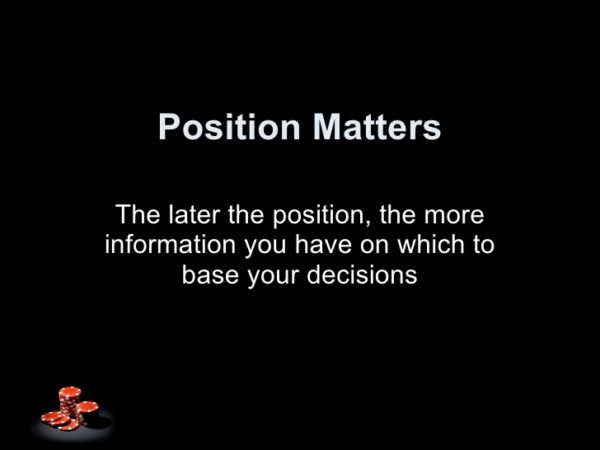
There is only one seat at the poker table that grants you “absolute position,” and that’s the button. When you’re on the button, you can be 100% certain that you’ll have the last say on the flop, turn, and river, no matter what. That’s a significant advantage on its own.
So, with that in mind, you should always look for opportunities to get involved from the button as often as you can. If there is no action in front of you, you’ll want to open with a fairly wide range of hands and stake your claim to the pot.
If there is a raise ahead of you, look for hands with which you can call or 3-bet. Poker is like a sport: you need to adjust your strategy versus different opponents, and if you find weak players in the blinds, you can play many more hands than GTO strategy would suggest.
The point is, you have the opportunity to be on the button once per orbit, so you want to make the most of that opportunity. Of course, you can still muck your weak hands and stay out of trouble, but you ought to try to expand your range of hands as much as you can get away with and put your inherent positional advantage to good use.
Unless you’re on the button, position isn’t guaranteed. So, every time you want to play a hand, you’ll want to give yourself the best chance actually to claim that positional advantage. This means that you want to play aggressively and always come in for a raise if you decide to play a hand.
By raising, you’re making it less likely that the players behind you will get involved because you’re making it more expensive to stay in the hand and you’re advertising that you’ve got a strong hand.
With this approach, you’ll often end up exactly where you want to be, playing against players from the blinds where you will have position. Of course, this won’t always work, so you should have a backup plan for when you reach a flop and have to deal with one or more in-position callers.
Many players make a mistake of playing far too many hands in the blinds, feeling they have to defend the chips they have already put in the pot. With that said, the small and big blind are the two worst positions in poker, so there is no way to overcome this disadvantage completely.
In all likelihood, no player on the planet makes money from the blinds in the long run, so that should not be one of your aims. The best you can hope for is to lose less and that’s only possible if you’re smart about picking the hands that you play.
The problem with defending blinds too wide isn’t just the money you put in before the flop; it’s also about having to play weak hands out of position, trying to somehow guess what your in-position opponent might have. If you do this too much, you’ll be leaking money.
While you don’t want to let other players run all over your blinds, you need to have a reasonable defense range and make the best out of the situation. You can’t avoid being in the blinds, but you can learn what hands you should and shouldn’t be playing against players from other positions to create a very effective overall strategy.
Of course, everything changes when there are antes in play since that gives you outstanding odds to play even extensive ranges, even from poorer positions. However, if you are sticking to a regular cash game 100bb deep with no antes, defending too wide can be a costly mistake.
Playing Texas hold’em, you have three racks full of chips in front of you. Certainly, you can readily understand why your opponents gaze with envy. What thoughts must come into their minds? “Boy, he’s a big winner. He must be a very good player.” They have boundless respect for you and will play cautiously when in a hand against you.
That doesn’t necessarily mean that you are actually a big winner. Maybe that person just won some money playing slots online at a site like DuckDice Casino and decided to try and parlay it into even bigger winnings at the poker tables. For example, I have seen players come to the table carrying two or three full racks. The players already seated may be so absorbed in their own hands that they fail to take note.
And, of course, players who subsequently join the table are not aware that all those chips were not actually won. They assume that you did win most of those chips.
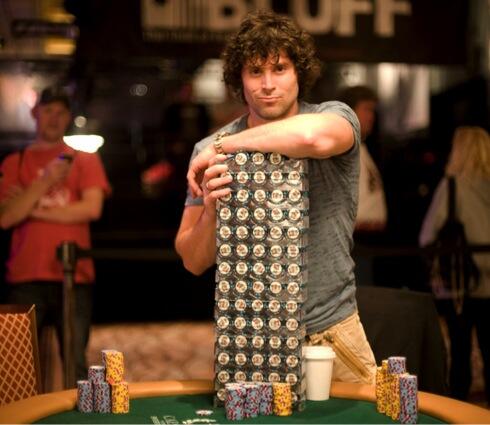
In any case, the result is that your opponents have much respect for you and may fear you. Sure, that’s great for your ego; but, far more important, that image of being a winner will help your poker success; so, you gain more self-confidence – that helps too. Betting or raising with self-assuredness makes your opponents fear you even more – all to your advantage. This is your Big Winner image – and it’s wonderful.
A scare card that could have made a player’s hand falls on the turn. From an early position, you bet out. Unless that card happened to actually improve your opponent’s hand – a long-shot, he mucks his hand – leaving the pot for you. We call that “stealing the pot.” It works best against one or two opponents. With three or more, there is just too much chance that one of them will be holding a strong hand.
Better yet would be if you are in a late position (the Button is best) and it’s been checked around to you. Instead of checking along, bet out. Your opponents all fold; and you have stolen another pot. Sure, it’s deceptive; but that’s part of the game. (Deception is a skill that every winning player has mastered.)
On the other hand, there may well be occasions when one opponent defies your aggressive action and raises your bet. Better consider the chances that he has the goods. Ponder his playing traits. Check your poker notes. Is he a tight player? If so, most likely he has the best hand. Folding would be prudent. Should he be deceptive (like you are), then a re-raise might work for you. He does not know what hand you hold and can only guess from how you have played your hands. Meanwhile, as he looks across the table and observes your lofty racks of chips, he is more likely to muck his hand.
Caution: If your opponent does indeed hold a monster hand, and beats you out of the hand, some of your opponents will then be more likely to call your opening bets and raises – at least for a short while. In other words, your image sometimes changes over time at the felt. For a round or two, avoid using deception. Play it straight.
What if you have lost several hands and your racks of chips have plummeted down to a few stacks? (Unfortunately, it happens.) Quietly, unobtrusively, without gaining notice, buy another rack of chips so you might keep your Big Winner image.
At the end of the day, much like that famous Andre Agassi marketing campaign Canon had 30 years ago, “Image is everything.”
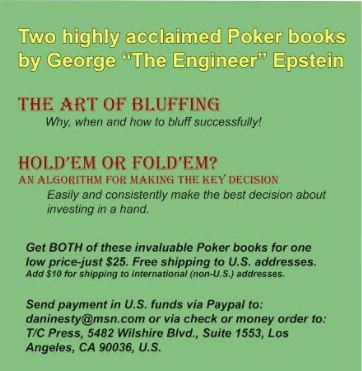
When it comes to tipping in live poker, everyone’s got an opinion. From the moment the first pot was pushed to a hand’s winner, the question of if and how much ought to be tipped to the dealer has been on poker players’ minds. That said, just as the game of poker itself has evolved over the years, to a degree so have attitudes towards tipping.
Tipping itself has a long history in the world. It is a practice that is thought to have extended back to Europe and, in particular, 17th century England, where the term “tip” is thought to have originally an acronym. “To Insure Promptitude” was allegedly printed on bowls in British coffee shops, and the rest, as they say, is history. Tipping is of course common in numerous fields and people regularly give tips to wait staff, to baggage handlers, and all manner of service industry professionals – according to the folks at oddsusa.com, even to clerks who handle your sports bets.
In any event, the history of tipping has also been coming under fire in recent times. In some Asian nations, tipping is considered offensive to the servers. Even in the USA, the attitudes regarding the practice are beginning to change towards phasing out the practice. So, how does the practice of tipping work in casinos, and will it – or should it – change?
Looking for a few poker players (recs and pros) and a couple dealers to take part in an article I’m writing regarding tipping.
Please get in touch if you’d like to participate AND you can give me quick turnaround time.
Thanks!
— Robbie Strazynski (@cardplayerlife) February 18, 2020
Cardplayer Lifestyle took up the challenge with a survey that, while not completely scientific, offers some insights into what poker players and industry employees think of the practice of tipping. Recreational players, professional poker players, dealers and card room staffers all responded to the five-question survey, with some expected answers and some curveballs tossed into the mix. This, the Great Poker Tipping Survey of 2020, perhaps gives an indicator of where tipping is at in the world of poker.

Over two dozen people submitted responses to the following five questions we asked:
Surprisingly, perhaps, players overall didn’t have much of an issue with tipping the dealers. Most of the time, the dealers are recognized for having to put up with a great deal of crap and for less pay than other jobs in the casino. “I have friends who are dealers and people in the service industry… I know how hard these people work and the shit they have to deal with on a daily basis,” Patrick Reynolds, a recreational poker player, stated in his survey. “I think it is very important that people are able to make a living wage.”
This was a sentiment that was echoed across the board – that it was important that the dealers earn a decent living for the job they do. “I know the dealers are not necessarily paid well,” Dan Eckroth, another recreational player, said in his survey. “If they were, the establishment would let us know and take away the tip drop box.”
Professional poker player Ryan Laplante expressly stated it that it is the responsibility of not only the players but the casinos themselves to make sure that the dealers are taken care of. “Dealers getting paid well is important. (The relationship) between players and the casino (should) make sure they are compensated. Most casinos pull 2-5% out of each (tournament) buy in to pay directly to staff, although floors, tournament directors (TDs) and management tend to take a high cut from it.”
Professional Brian Soja had similar thoughts to Laplante. “(While) I play a game with my money, for money, to make a living, many of the people that work in the industry would gladly trade places with me,” Soja said. “Much of the staff in casinos earn minimum wage…they truly rely on tips to make ends meet. It’s hard for me, in good conscience, to walk in there day after day and play a GAME with my money and not show my appreciation for all the people that make it possible for me to earn my living.”
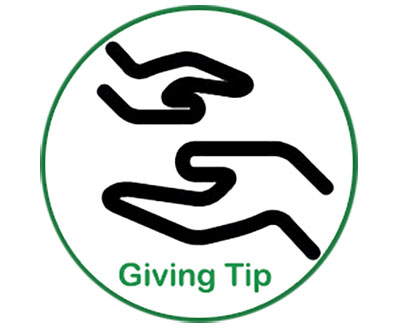
For the most part, players stated that they are always tipping the dealers unless there are special circumstances such as poor performance. “I virtually always tip,” poker pro Brian Hastings responded on the survey. “There’s a VERY small amount of times I’ve declined to tip, generally due to a dealer either behaving rudely or making a mistake that was because of a lack of effort. But I’ve only withheld tips in a handful of egregious cases.”
Recreational player Michael Bernstein noted that he always tips, as it’s “the cost of doing business” by playing at the tables, even in situations where dealers are terrible. “If they’re not paying attention, I’ll still tip, but while doing so I’ll give the dealer some attitude or at the very least clear notice that they ought to be doing a better job.”
Although the entirety of the respondents to the Cardplayer Lifestyle survey agreed on the dealers receiving tips, there were some deviations amongst the panel as to other staff of a poker room – the floormen/women, cashiers, and others. The general belief of the survey panel was that these casino employees were generally better compensated than the dealers and, thusly, weren’t looking to the tips as a way of “making a living.” “In a restaurant, we always tip our server, (but) not the management,” pro player Jamie Nixon stated. “In some scenarios, floor staff COULD be tipped, but they are usually paid better and occasionally will receive some form of bonus based on turnout (or other performance-based factors).”

for illustrative purposes only
Some people believed that other personnel in a poker room didn’t get tipped because they aren’t as necessarily as noticeable as the dealers are in the game. “Dealers are just more visible (in) the game,” rec player Eric Wroblewski observed. “I understand that everyone involved is a critical piece to the poker game running, but the dealer is the one directly involved. I did hit a bad beat jackpot once while playing in Arizona and, after Googling tipping etiquette, tipped everyone that night!”
Greg Jennings, a semi-professional player, did point out an issue, however. Players are notified if there is a percentage of their tournament buy-ins removed for the house and, in particular, the dealers and staff, but they aren’t informed of what the breakdown is as to that percentage. “The tournaments/payout desk don’t make clear how tips are divvied; this information should be posted and/or documented in some manner.”
So tipping is still going on in the poker room? What’s the “right” amount to tip?
There was a wide variance among the respondents to the Great Poker Tipping Survey of 2020 and there were some qualifiers in the responses. “If I am in a cash game, it’s $1 per pot,” Chris Johnson, a recreational player, responded to Cardplayer Lifestyle. “If I hit some kind of jackpot, I’ll tip 10% under $600 and 7% over that amount.”
Rec player Heather Gearan pointed out this dilemma well – what DO you do when you make the big score? And does the room make a difference?
“So many factors go into that decision,” Gearan said, “and it’s a really complicated calculus which…is impossible to get right. I’ll tip a higher percentage on a tournament where I know the dealers are depending on that tip than one in which there is a healthy dealer add-on. And it may be wrong, but I find it hard to tip as large a percentage in an unfamiliar room. I still tip fairly but tend toward the lower end of my range.”
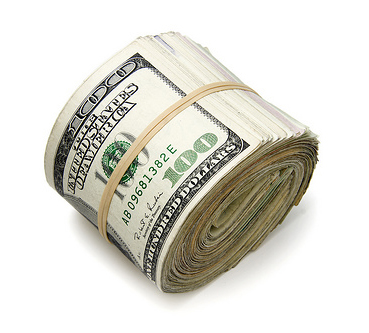
“The tip will also be lower on a really big cash,” Gearan continued. “Twelve percent of $250 is $30…that’s a no-brainer. My husband, Paul, won $11,000 in a bad beat a couple years ago and 12% is over $1300…he spent a long time agonizing about that tip, but ended up around $1000.”
Ed. Note: We’ve profiled Heather and Paul – the Poker Pilgrims – in the past. They’ve got a great story.
One person who is never afraid to let his positions be known is well-known poker industry personality extraordinaire Matt Savage. The Executive Tour Director for the World Poker Tour and the Tournament Director of the Commerce Casino and Bay 101 Casino, Savage is constantly striving to improve the poker experience for both the workers and the players. “I think that tipping dealers or anyone in the service industry is just a part of the game,” he stated. “If you received excellent service then leaving an additional 1-3% based on the (tournament) buy-in is always appreciated.” He also believes that there shouldn’t be a set percentage, however, because of factors like a buy-in size to consider, and that pros aren’t necessarily going to be tipping as much as recreational players.
Charity poker room manager Rick Brown pointed out that dealers get “servers’ wage,” which is usually much lower than the legally mandated minimum wage. Thus, dealers need the tips to offset the difference. “If you don’t tip the dealers, then people leave the profession,” Brown firmly said. “Usually the best dealers deal cash games and, if you want to keep the best dealers, you have to take care of them.”
Brown also noted the differences between tournaments and cash games. “All of our tournaments end in a $5 amount. Most players buy in for $35 or $45 and then tip the dealer $5,” he said. “If they cash the tournament, they tip again. (In cash games), it is usually $1 a hand, going up as the pot is bigger, but some people only tip $1 no matter what.”
Everyone who responded to our Great Poker Tipping Survey of 2020 pretty much agreed that tipping is necessary for dealers in the poker rooms. Because those dealers are usually being paid less than a minimum wage, the tips help to offset the financial difference that they face. When it comes to the floor staff and cashiers, there’s a little diversity in opinion – in some cases, they should be tipped, but not as much as the dealers.
There are also some differences in cash games and tournaments and in just how much said tip is going to run a person – someone is not going to think twice about tipping a $1 on a $10 pot, but that becomes a bit different when you’ve cashed for a million dollar payday. The bottom line is that tipping in the poker room is still quite prevalent in the industry and it is dependent on the player involved, but every respondent in our survey felt that it should occur.
Perhaps Ken Kaulen Jr., President and co-founder of Chicago Charitable Games, Inc. said it best: “Not tipping a dealer at a casino is like going to a dinner, getting served by a waitress and then not leaving her anything. Almost every job I have worked since I was a kid all the way until after college I worked in the service industry. When you have survived on tips, you end up being a better tipper.”
In this episode of The Bernard Lee Poker Show on the Cardplayer Lifestyle Podcast Family, Bernard Lee interviews professional poker player Maria Ho, who hosted the 2nd Annual Global Poker Awards at the PokerGO Studio in Las Vegas. Maria discusses her role as hostess and gives us a behind the scenes look at the event. Finally, Maria discusses her potential schedule from now through the 2020 WSOP.
| 0:00 | Welcome to The Bernard Lee Poker Show as this week’s guest will be professional poker player, Maria Ho. |
| 0:53 | Bernard reviews the winners of the 2nd Annual Global Poker Awards. |
| 4:24 | Cody Stanford won the RunGood Poker Series Main Event at the Horseshoe Tunica. He beat a field of 523 entries and took home the RGPS ring and $41,724. |
| 5:22 | Zach Mullennix captured the WSOP Ameristar St Charles Main Event in the St. Louis area. He beat a field of 281 entries, earning the WSOP ring and $92,886. |
| 8:18 | RunGood Gear Ad |
| 9:00 | Bernard welcomes Maria Ho to the show. |
| 10:18 | Maria joins the show. |
| 10:40 | Discussing her role as hostess, Maria talks about the behind the scenes of the event including the production meeting and last-minute changes of the 2nd Annual Global Poker Awards that was held in the PokerGO Studio in Las Vegas. |
| 18:35 | Maria talks about how some of the winners who couldn’t attend were asked to make an acceptance video without fully knowing if they had won. |
| 19:02 | Maria expresses happiness that Rob Campbell won Breakout Player of the Year, especially as he is primarily a mixed game specialist. |
| 22:20 | Maria explains her comment to three-time winner Kristen Bicknell. She also discusses the Award of Merit (Live Tournament Reporters), Poker Icon Award (Johnny Chan) and Hendon Mob Award (“Miami” John Cernuto). |
| 29:44 | Share My Pair Ad |
| 30:16 | Bernard continues his interview with professional poker player, Maria Ho. |
| 31:53 | Maria discusses her reaction to some of the repeat winners including photographer Drew Amato and RunGood Poker Series President Tana Karn. |
| 35:16 | Maria remembers Hand of the Year and the video from the winner Ryan Riess, who had made an all-in call with a 10-high. |
| 38:18 | Maria discusses some of the winners including Twitter Personality of the Year (Jamie Kerstetter, Tournament Director of the Year (Matt Savage), Charitable Initiative of the Year (Scott Wellenbach) and Journalist of the Year (Joey Ingram). |
| 47:29 | Maria reminisces about the PokerStars Caribbean Adventure (PCA) in the Bahamas. |
| 49:30 | Maria talks about plans of the rest of the Spring and the WSOP. |

Maria Ho
Imagine taking a course in college. You sit down for your first day and the professor drops the entire semester’s workload in front of you and says, ‘here ya go, see you in a few months’.
This is what it can feel like when you join a poker training site. Where do you even begin? The amount of content on sites can be daunting. Sure, there may be specific elements of your game you want to work on, but to level up your entire poker game, with the countless options out there, it can be intimidating and downright off-putting trying to navigate your way around.
I’ll fully admit to having bailed on a training in the past because it was too frustrating. Sifting through the countless videos, webinars, articles and forums, not really finding precisely what I wanted, and not having a direction for an overall learning path; it was incredibly overwhelming.
Jonathan Little’s Pokercoaching.com has recognized this hurdle potential students face and created a new section on the site, titled appropriately – Learning Paths.
With the growth of the site over the past year – expanding the amount of content, the number of coaches, and introducing PokerCoaching Premium, Pokercoaching.com has never had more content options.
While this is incredible for students looking to improve their game, a road map could be useful to help them along. This is exactly what’s been provided – in four forms no less – divided into cash game and tournament paths, and basic and premium levels of PokerCoaching.com memberships.
We’ll go into detail of each section in a minute, but first I’ll break down the various elements of content available, as PokerCoaching.com is far more than just training videos.
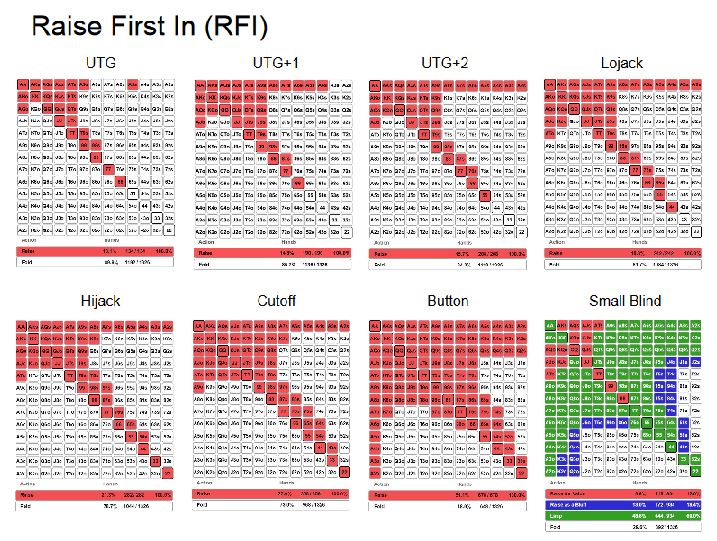

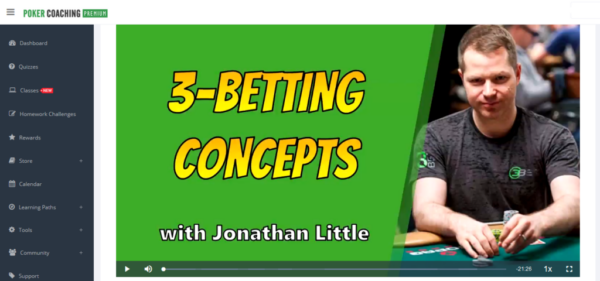



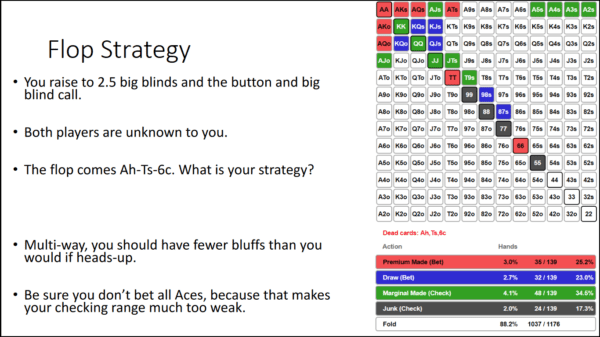

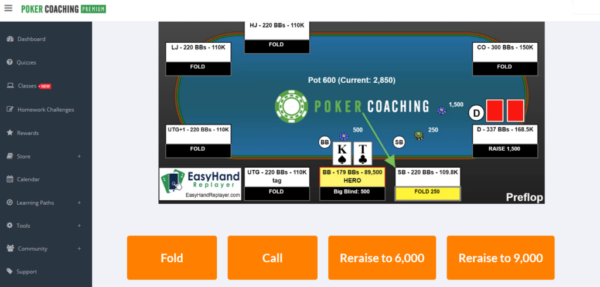

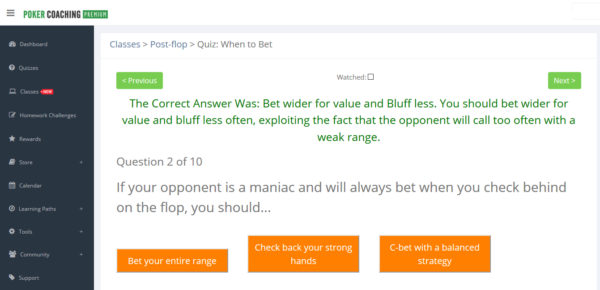

All these elements will be incorporated into the learning paths, so let’s take a look at how they’re laid out.
*Of note, though this review of the PokerCoaching Learning Paths is pretty thorough, breaking down each element in detail would take quite a while, so we’ll just be touching on the key points of each. It’s up to you to fully discover and enjoy!


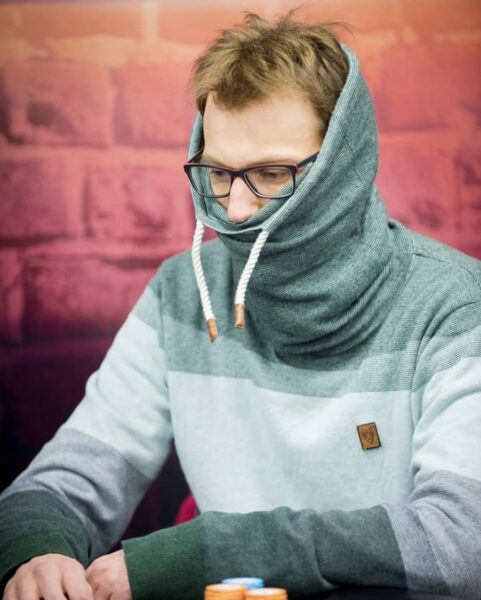

As illustrated above, the Learning Paths available with a basic PokerCoaching membership are both excellent and very thorough, with not just strong fundamentals preached, but plenty of extended teachings as well. However, if you want to take things to another level, the offerings in PokerCoaching Premium are just that, premium. They include a notably larger amount of content and are well worth the difference in membership price. Specifically, the 30-Day Tournament Preparation Challenge is phenomenal (my review here).
The primary basis of the PokerCoaching Premium cash game learning path is Little’s outstanding Cash Game Master Class. A few months back, I wrote a review of that course that gives a VERY THOROUGH breakdown of each of the 20+ videos in the series. I will say this though: after studying the Cash Game Master Class for that review, I was able to turn an 8-month downswing around in just three months, and my graph has kept soaring in the months since. It’s an absolute game changer, and I can’t speak highly enough about it.
Successful revenge tour yesterday.
We got em at PH, Flamingo and Mirage to the tune of 40 BB / hour for the day.
Now to fuel up before starting today in my favourite room in Vegas. @AriaLV @ARIAPoker pic.twitter.com/6wIGu32y0Y— Mike Patrick (@MikePatrick98) November 27, 2019
Here are the other elements of the PokerCoaching Premium cash game learning path:
*There is a LOT here. This is the largest Learning Path of them all, so I’ll stick to just discussing the videos and webinars. There are an additional dozen quizzes and a pair of homework challenges as well.
As if this all wasn’t enough, the back end of the Premium Tournament Leaning Path adds several full courses and 2-hour webinars that feature some lengthier and even more in-depth teaching on several specific topics, including:
While it might be tempting to do so, you most likely won’t be running off to your local casino and immediately crushing after a weekend of bingeing any of these four Pokercoaching.com Learning Paths.
The fact of the matter is that, like any true type of learning, they’ll take time and effort to fully absorb. But that’s what we signed up for isn’t it?
When I was tasked with writing this review, since there’s simply just so much material to cover, the intention was to just provide an overview of the many elements provided and give a brief synopsis. It wasn’t possible. I burrowed into so many sections, and will continue to dig through them repeatedly in the future. The ability to have so much great training laid out with a set direction to take and a variety of content along the way was so welcoming.
Settle in, New Student of PokerCoaching.com. Your professors aren’t going anywhere.
Poker profits are the lifeblood of your poker journey. If you don’t win at the tables, you have to continually replenish your poker bankroll from your life roll. How long will your significant other allow that without it causing a rift in the relationship? Probably not long. And if you’re unattached, it’s of course still not a pleasant thing to have to keep doing.
However, if you’re the type of player who doesn’t mind continuously replenishing your bankroll, then great! I want you sitting at my table.
Most players, though, want to build a bankroll from poker winnings so they can enter bigger games to earn even more money.
So, how do you know how successful you currently are in your poker journey? You wouldn’t run a business without knowing your daily/weekly/monthly profit and loss, right? The same holds true for poker players. You must measure your profits to gauge how your current skills stack up to your competition.
Let’s go over a few ways of measuring your profits and if you aren’t already tracking one or more of these, take action and start today.
The ultimate measure of a poker player is how much they’re adding to their bottom line. You should have a poker bankroll separate from your life roll so you can track this accurately. If you mix the two, you can’t calculate how much money your poker play is adding (or subtracting) from your bottom line.
I recommend keeping track of the size of your bankroll every week. You can use your poker journal and a pen, an Excel spreadsheet, or maybe even a smart phone app like Poker Notes Live, Poker Bankroll Management or Poker Bankroll Tracker.
The ups and downs of your bankroll might clue you in to areas of opportunity. Have you played too many late-night poker sessions with a few beers or glasses of wine, and taken a huge hit to your bankroll? Then you may have found a leak in your game!
Have you seen a spike in your bankroll after you decided to get more rest every night and do a pre-session warm-up every day? It appears these had a beneficial effect on your play, and ultimately, on your bankroll.
Keep doing what works and avoid what doesn’t.
Besides the bottom line, there are some other profitability measurements that help gauge your success on-the-felt.
Return on Investment (ROI) in poker is a measurement of the gain or loss from your time at the tables and it is related to the amount of money invested. ROI is calculated as the Net Profit / Total Costs and is presented as a percentage.
For example, if you play one $80 tournament (cost) and cash out for $140, your net profit is $60. The ROI you achieved in this one tournament is the net profit of $60 divided by the $80 cost = .75 or a 75% ROI. That’s a good return.


However, it’s also possible to have a negative ROI. Let’s say you play in 10 of these $80 tournaments for a total cost of $800. After adding up all your results, you cashed for only $500. This leaves a net profit of -$300. The ROI for these 10 tournaments is -$300 / $800 = -.375 or -37.5%.
Another way for tournament players to measure their profits is with a win rate. This is the amount of money won or lost divided by the number of instances you’re tracking.
Following up on the above example:
It’s tough to sustain a poker tournament hobby with negative results like these. This player needs to put in more off-the-felt study time.
CHECK IT OUT: The Best Poker Training Sites
Cash game players don’t track profitability with return on investment. Instead, there are 3 common win rates they use:
This is the same as measured above for tournament players, and it’s especially useful to see the value of each hour you spend on the felt. If you played 100 hours in February with a net profit of $2,000, you earned $20/hour.
That’s great if you’re working a job that pays only $12/ hour. Your poker hobby is paying you more. But, if you’re thinking about quitting your $12/hour job, and your hourly poker profit is only $8/hour, then you’re not ready to quit that job just yet.


You can also measure your win rate by session. Maybe it took you 14 sessions to earn $2,000 in February. Your win rate per session = $2,000 / 14 = $143/session. That’s a lovely win rate and this measurement works well if you’re not good at tracking your time on the felt.
The most common profitability measure for online players is the number of big blinds won per 100 hands played (BB/100 Hands). This is tough to record for LIVE poker players, but online players have PokerTracker 4 which does the recording and calculations for you.
The BB/100 hands win rate is a great apples-to-apples comparison for tracking profitability. Let’s say you played 20,000 hands each in $10, $25 and $50 buy-in games. Your BB/100 hands win rate is how you can compare your profitability in one stake versus another. If you just look at $ won, then most likely the majority of your profits comes from 50NL, with 25NL giving you a smaller portion of profits and 10NL being the least. But by looking at the apples-to-apples BB/100 hands comparison, you can see how you’re doing at the different stakes.
Your records don’t have to be anything fancy. Just keep your bankroll separate from your life roll and record your bottom line along with 1 or 2 other measurements to gauge your profitability.
In my next article, I’ll give you simple strategies you can use to improve your ROI and win rates.
For more great coaching, strategies and tips from Sky Matsuhashi, check out his poker training site, The Poker Forge. Here’s our review.